Text
November 30 - St. Andrew's Memorial Day
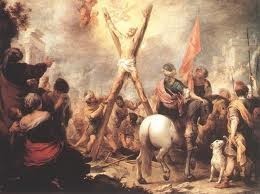
A painting by Bartolomeo Esteban Murillo. "The Martyrdom of St. Andrew".
St. Andrew, the Apostle, Andrew the First—called is the first of the disciples of Jesus Christ, the brother of St. Peter the Apostle. According to the Russian chronicles, Saint Andrew preached Christianity in the Slavic lands. According to legend, the Apostle Andrew was martyred in the city of Patras in Greece.
Sentenced to death, he appealed to the authorities with a request not to crucify him on a cross of the same shape as the one on which Christ was crucified. His request was granted and, as it is believed, Saint Andrew died on the oblique cross made of two logs, which later became his symbol. It is from this cross that the multi—faceted "St. Andrew's flags" - Scotland, Ireland, the Russian Navy and others - originated.
St. Andrew the Apostle is the patron saint of Russia, Scotland, Greece and Romania.
Read more in the post "St. Andrew's Day"
Photo rating on the topic "Paintings about the execution of the Apostles".
*Translated using an electronic dictionary. The original text in Russian and much more on the criminal topic can be selected on the main page of the site - http://crimerecords.info/
0 notes
Text
November 27 is the Day of Remembrance of Medical students in Cuba who died at the hands of the Inavn government

On November 27, 1871, eight first-year students of the Havana Medical University were shot by order of the Government in Havana. Anacleto Bermudez Gonzalez, Alonso Alvarez, Pascual Rodriguez Perez, Carlos Augusto de Latorre, Angel Laborde, Carlos Verdugo, Eladio Gonzalez Toledo and Jose de Marcos Medina - all of Cuba knows their names.
They were accused that on November 23, 1871, when they were wandering around the university while waiting for a delayed teacher, they scratched the glass of the tombstone of Gonzalo Castagnon, a reactionary Spanish journalist who was killed in Key West in a duel with a Cuban. Castagnon sang the praises of the Spanish regime, and therefore the authorities in Cuba considered him almost a saint. 45 students were arrested for desecrating his grave, 30 were sentenced to various terms of imprisonment, 8 to death. It is said that a year later, Castagnon's son confessed that his father's grave was in perfect order and the accusation was false.
Nevertheless, the students were executed. As Ernesto Che Guevara said, "Their only crime was that they were Cubans."
After the revolution in Cuba, executed students who were posthumously acquitted are already revered as saints. On Liberty Island, young people are honored as those who died for the cause of the revolution. November 27 has been declared a Day in Cuba to honor students who died at the hands of the Spanish government. On this day, according to tradition in Havana, students of higher and secondary institutions organize a march that starts from the University of Havana, continues along San Lazaro Street to La Punta esplanda, where students were shot and ends in the city park.
*Translated using an electronic dictionary. The original text in Russian and much more on the criminal topic can be selected on the main page of the site - http://crimerecords.info/
0 notes
Text
November 20 is the Day of Consciousness of Blacks in Brazil.

Proclamation of Zumbi as the leader of kilombu
Zumbi (Zumbi) was the leader of the Negro state of Palmaris that existed in Brazil in 1678-1694.
In the 1630s, several Quilombu in northeastern Brazil merged into a Negro state known as Palmaris. The leadership of the state was carried out by the supreme leader who was elected for life, in whose hands all the highest secular and spiritual power was concentrated. The main tasks of the country's leadership were to ensure the defense of Palmaris by the forces of the general militia and the creation of warehouses with food and weapons.
Quilombu Palmaris constantly attracted slaves from all over Brazil and even Dutch Guiana, and therefore the Portuguese and Dutch colonialists began to send numerous punitive expeditions against them. However, the inhabitants of Palmaris stubbornly defended their independence: they managed to break up a total of 58 expeditions.
Zumbi quickly became known for his prowess and cunning in battle. He participated in several battles with the colonizers, was wounded. When peace was concluded between the warring parties in 1678, Zumbi, harboring distrust of the Portuguese, refused to recognize this agreement and became the new supreme leader of Palmaris. Soon, the defenders of Palmaris, led by Zumbi, managed to expel the colonizers from their territory.
He made many successful raids into Portuguese territories, so a large reward was announced for his head. But only 15 years later, in 1694, having gathered a large army, the colonial authorities undertook a blockade of the capital of Palmaris - Macaque - and soon captured it. Most of the inhabitants of Palmaris died.
However, Zumbi managed to escape from the Portuguese and continue fighting for almost two years. On November 20, 1695, he was handed over to the authorities by a mulatto, captured and beheaded on the spot. Zumbi's head was transported to Recife and put on public display in the central square.
In modern Brazil, the day of Zumbi's death, November 20, is celebrated as the Day of Consciousness of the Dark-Skinned (Consciência negra), which has a special meaning for Brazilians of African descent. They honor Zumbi as a fighter for freedom and independence.
*Translated using an electronic dictionary. The original text in Russian and much more on the criminal topic can be selected on the main page of the site - http://crimerecords.info/
0 notes
Text
November 11 – St. Martin's Day

Martin of Tours (Martinus Turonensis) is the bishop of Tours, one of the most revered saints in France.
Martin grew up in a non-Christian family, and his father insisted on his military career. It was then that the saint came to Gaul, where he served as an officer. His most famous act was a noble act towards a beggar.
One winter, during a terrible snowstorm, Martin was riding a white horse and met a naked beggar shivering from the cold. The soldier took out his sword, cut his uniform cloak with it and gave half to the freezing poor man. The night after the incident, Martin had a dream. Jesus Christ appeared before him, wrapped in half of that cloak, and said: "You have done good for my brother, so you have done good for me." After this dream, Martin left military service and devoted himself to the service of God. Subsequently, he became the patron saint of all beggars, and for his kindness and concern for the poor, he was called Merciful.
Saint Martin was not a martyr, did not suffer torture and suffering. And the most criminal incident happened to him after his death.
Saint Martin died while praying in Candes, in a church located above the confluence of the Vienne and Loire rivers. The locals wanted to bury him at home, but the residents of Tura stole the body, exposing the window of the temple, and went with him upstream on boats. God must have considered this theft a good deed, because, despite the autumn season, flowers bloomed and birds sang along the way. The relics of St. Martin from the 5th century to the present day rest in the Basilica of St. Martin in Tours.
Over time, the church fathers assigned the late Saint Martin the "position" of patron of all shepherds, winegrowers and millers. Catholics celebrate St. Martin's Day on November 11, coinciding this date with the day of his burial – November 11, 397. And the Orthodox have everything in their own way, they set aside for the memory of St. Martin on October 25 (October 12 according to the Art. style).
Read more in the post "St. Martin's Day"
*Translated using an electronic dictionary. The original text in Russian and much more on the criminal topic can be selected on the main page of the site - http://crimerecords.info/
0 notes
Text
November 9 is a special day in the history of Germany

November 9 is a special date in the history of Germany of the twentieth century, it is also called the Fateful Day (Schicksalstag).
On November 9, several significant events occurred for Germany: in 1918, Kaiser Wilhelm II abdicated the throne, 5 years later the famous "beer hall putsch" in Munich, led by Adolf Hitler, was suppressed, 15 years later the National Socialists organized Jewish pogroms, and in 1989 the Berlin Wall fell.
Germany in the twentieth century experienced many ups and downs, but eventually became the most prosperous European country. And a great merit in this is Ludwig Wilhelm Erhard.
Read more in the post "Fateful day in Germany".
Article on the topic "Economic miracle worker Erhard".
*Translated using an electronic dictionary. The original text in Russian and much more on the criminal topic can be selected on the main page of the site - http://crimerecords.info/
0 notes
Text
November 8 - Ancestral Memorial Day in honor of the 1916 uprising against the Russian Empire in Kyrgyzstan

In 2018, the President of Kyrgyzstan Almazbek Atambayev signed a decree according to which History Day will be celebrated in the country on November 7, and on November 8 – the Day of Remembrance of Ancestors in honor of the 1916 uprising against the Russian Empire.
The rebels were dissatisfied with the oppression by the tsarist authorities, the seizure of land in favor of Russian immigrants, and the increase in taxes. The last straw was the decree of the Russian tsar on mobilization, which called on the indigenous population of Central Asia to participate in rear works during the First World War.
The uprising began on July 4, 1916 in Khojent, Samarkand region (now Khujand, Tajikistan). Soon it covered the Samarkand, Syrdarya, Ferghana, Transcaspian, Akmola, Semipalatinsk, Semirechensk, Turgai, Ural regions with more than 10 million multinational population.
One of the first to announce the beginning of the "holy war" against the "infidels" Kasym-Khoja, the imam of the main mosque of the village of Zaamin, proclaimed the "Zaamin bek". He organized the murder of the local bailiff Sobolev, after which he appointed "ministers" and announced a campaign to the stations of Obruchevo and Ursatievskaya. On the way, his squad killed all the Russians who got in the way. In fact, the Kyrgyz uprising was anti-Russian in order to create a Muslim state in Russian Turkestan. The mutiny escalated into a massacre. Later, the uprising was severely suppressed. Many Kyrgyz, as well as other protesters, had to flee from the persecution and punitive operations of the Russian army to China.
During the Soviet period, the uprising was glorified, it was declared an uprising against the autocracy, national and religious motives, as well as the atrocities of the rebels were completely ignored. Such leaders of the uprising as Amangeldy Imanov and Alibi Dzhangildin were credited with revolutionary and socialist views, the struggle against the tsarist bourgeoisie, many streets and settlements in Kazakhstan were named after them.
Read more in the post "Ancestral Memorial Day in Kyrgyzstan"
*Translated using an electronic dictionary. The original text in Russian and much more on the criminal topic can be selected on the main page of the site - http://crimerecords.info/
0 notes
Text
November 5 is the International Day of Remembrance of Animal Advocate Barry Horn.

A scavenger from Liverpool, Barry Horne, loved animals very much and protested against vivisection.
Only protested in a very peculiar way – arranging explosions. People were not affected by his actions, but the damage from a series of explosions organized by him in 1994 on the Isle of Wight amounted to three million pounds. It is clear that the fuse was searched hard, and finally, in 1996, Horn was detained in a supermarket in Bristol in 1996. The court sentenced him to 18 years in prison.
In protest, Horn went on hunger strikes three times in prison. The third of them, which lasted 68 days in Long Lartin prison, became fatal for him. Barry's liver failed and he died on November 5, 2001.
*Translated using an electronic dictionary. The original text in Russian and much more on the criminal topic can be selected on the main page of the site - http://crimerecords.info/
0 notes
Text
November 5 - Guy Fawkes Night in the UK (Guy Fawkes Night)

Guy Fawkes' Night is a traditional, but not public, annual holiday in the UK on the night of November 5.
This night marks the failure of the Gunpowder Plot, when a group of Catholic conspirators tried to blow up the British Parliament in London on the night of November 5, 1605, during the throne speech of the Protestant King James I, when, besides him, members of both houses of Parliament and supreme representatives of the country's judiciary would have been present in the House of Lords building.
Guy Fawkes tried to set fire to barrels of gunpowder in the basement of the Palace of Westminster. One of the accomplices warned the royal Lord William Parker, 4th Baron Monteagle about the planned explosion and told him not to come to the palace building the next day. And he warned the king, and the next day Guy was arrested and taken to the Tower.
In the UK, fireworks and bonfires are lit on this night, where an effigy of Guy Fawkes is burned. And the day before, the children beg for coins "for a great guy Guy" to buy firecrackers.
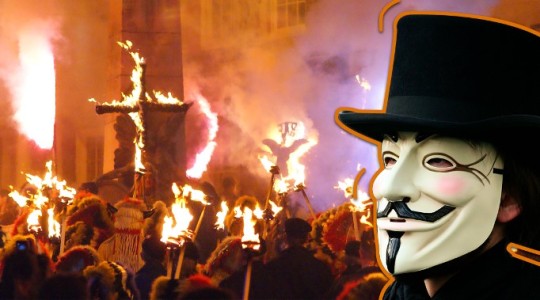
In addition to Britain, Guy Fawkes Night is also celebrated in some of its former colonies — in New Zealand, South Africa, the province of Newfoundland and Labrador (Canada), parts of the British Caribbean Islands and Australia.
Read more in the post "Guy Fawkes Night"
Article on the topic "Gunpowder conspiracy".
*Translated using an electronic dictionary. The original text in Russian and much more on the criminal topic can be selected on the main page of the site - http://crimerecords.info/
0 notes
Text
November 4 is the Day of the National Struggle against Oppression in Iran

On November 4, 1979, in Tehran, four hundred militant Islamic students from the Revolutionary Guard, with the support of a crowd of three thousand, seized the American embassy. 50 American diplomats were taken hostage. They were blindfolded and handcuffed. The terrorists demanded the return to Tehran of the wealth taken out by the deposed Shah Pahlavi, and the defrosting of Iranian holdings in the United States. The unsuccessful operation to free them, as a result of which eight American commandos were killed due to a collision in the air of two helicopters, cost President Jimmy Carter an election defeat. But on the last day of his presidential term, January 20, 1981, the hostages were released after obtaining the consent of the United States to unfreeze some Iranian accounts in American banks. The hostages were held in Iranian captivity for 444 days.
Since 1992, November 4 has been celebrated in Iran as the "Day of the National Struggle against Oppression". Thousands of people come to the building of the former US Embassy on this day, considering the hostage-taking a glorious milestone in the history of their state.
*Translated using an electronic dictionary. The original text in Russian and much more on the criminal topic can be selected on the main page of the site - http://crimerecords.info/
0 notes
Text
November 1 - Day of the Dead in Mexico

Day of the Dead (El Día de Muertos) is a holiday dedicated to the memory of the dead, held annually on November 1 and 2 in Mexico, Guatemala, Nicaragua, Honduras, El Salvador. According to legend, these days the souls of deceased relatives visit their home. The tradition goes back to the Mayans and Aztecs, who brought gifts to the goddess Mictlancihuatl and built walls with the image of skulls - tzompantli. On the Day of the Dead, cemeteries are decorated with ribbons and flowers, the roads to the houses of the deceased are made by their relatives with candles so that the deceased can find his way home.
The celebration calendar coincides with two Catholic holidays - All Saints' Day (November 1) and All Souls' Day (November 2). Traditions associated with the holiday include the creation of private altars in honor of the deceased, including sugar skulls, verbena, favorite foods and drinks of the deceased and visiting the grave with these gifts.
In 2003, the holiday was included by UNESCO in the list of intangible cultural heritage of mankind. These days a carnival is organized, sweets are prepared in the form of skulls and figures of dressed female skeletons resembling Katrina.
In 2004, students of the National Autonomous University of Mexico built a wall of 5,667 sugar, chocolate and caramel skulls, which is 2,667 skulls higher than the previous wall. The wall is listed in the Guinness Book of Records.
*Translated using an electronic dictionary. The original text in Russian and much more on the criminal topic can be selected on the main page of the site - http://crimerecords.info/
0 notes
Text
October 31 - Halloween

Halloween is a modern international holiday dating back to the traditions of the ancient Celts of Ireland and Scotland, whose history began on the territory of modern Great Britain and Northern Ireland. It is celebrated every year on October 31, on the eve of All Saints' Day. Halloween is traditionally celebrated in Western Europe and America, although it is not an official day off.
The prototype of Halloween most likely originated with the appearance of the Celtic pagan festival of Samhain, which was associated with death and the supernatural. Around the XVI century, there was a tradition of begging for sweets at night on October 31. Children and adults put on cloth masks and walked from one door to another, demanding treats and small shawls from the owners. The custom of wearing role-playing costumes and carrying a "Jack's lamp" appeared only at the turn of the XIX and XX centuries, and in exchange for money or food, it was initially necessary to offer various entertainments.
One of the most famous attributes of Halloween is a pumpkin lantern, or Jack's lamp. It is a hollow pumpkin, on which a sinister grimace is carved, and a candle is placed inside. It was believed that such a fruit, left on All Saints' Day near the house, would drive away evil spirits and other evil spirits from it.
Illustration by Jovan Ukropina. "Jack who fooled the Devil."
Jack's lamp represents "a soul not accepted into heaven or hell." There is such a legend associated with him:
On the way home, the drunk Jack met the Devil, but he managed to trick him around his finger - he asked the unclean to climb a tree for fruit, and as soon as he perched on the spreading crown, Jack scratched a cross on the trunk, thus captivating the Devil and bargaining for privileges for himself. Having spent his life in drunkenness and sin, Jack could not get to heaven after death. According to this promise, the Devil also did not take Jack to hell, but only threw him a piece of coal from the hellfire. That cold night, Jack put a smoldering ember in an empty turnip so that it wouldn't die out. Since then, he has been wandering the earth, unable to find a place for himself.
Read more in the post "Halloween".
*Translated using an electronic dictionary. The original text in Russian and much more on the criminal topic can be selected on the main page of the site - http://crimerecords.info/
1 note
·
View note
Text
October 30 - Memorial Day for Victims of Political Repression in Russia

The Russian people fought for freedom in 1917, and ironically found political repression. They began immediately after October 1917. Already in the first years of the Bolsheviks' stay in power, peasants - participants in anti-government protests, workers-strikers, members of socialist parties and anarchist organizations, clergy, sailors - participants in the Kronstadt "mutiny" of 1921, clergymen were subjected to mass repression. During the civil war, along with the "red" terror, there was also a "white" one. But then the right to political repression was privatized by the victorious Bolsheviks. They repressed not only individuals, but entire estates: nobles, Cossacks, clergy, wealthy peasants. There was an endless succession of lawsuits on professional affiliation: over the military, security officers, doctors, engineers, scientists. The peak of political repression was the notorious 1937. But even after that, at a later time, the repression did not stop. The regime brutally persecuted dissidents. The main object of the regime's repressive policy in the 1960s- 1980s was "dissidence". During the period from 1967 to 1971, the KGB authorities "identified" more than three thousand groups of a "politically harmful nature." Since the mid-1950s, psychiatry has been widely used to combat dissent.
The Day of Remembrance of Victims of Political Repression in Russia was first celebrated in 1991 in memory of the hunger strike of prisoners of camps in Mordovia, which began on October 30, 1974. Officially, this day was established by the Resolution of the Supreme Soviet of the RSFSR of October 18, 1991 "On the establishment of the Day of Remembrance of victims of Political repression." On October 30, commemorative events, meetings and rallies are held in our country, attended by politicians and public figures, human rights defenders, former political prisoners, young people, relatives and friends of those who died in Soviet camps.
Read more in the post "Memorial Day of Victims of Political repression in Russia"
*Translated using an electronic dictionary. The original text in Russian and much more on the criminal topic can be selected on the main page of the site - http://crimerecords.info/
0 notes
Text
October 28 - St. Jude Thaddeus Memorial Day

Judas Thaddeus (Judas Iakovlev or Levvey, Lebbaeus), brother of James Alpheus is one of the twelve apostles, disciples of Jesus Christ.
According to legend, the Apostle Judas preached in Palestine, Arabia, Syria and Mesopotamia and died a martyr's death in Armenia in the second half of the 1st century AD
. Somehow it turned out badly. In the Caucasus, Armenia is considered a stronghold of Christianity. For which she suffered greatly from the Turks. But it was in this country that the apostles Thaddeus and Bartholomew, the first enlighteners who brought Christianity to its lands, were put to the cruelest execution.
Saint Thaddeus was one of the 12 disciples of Jesus Christ. Having accepted his teaching, he began to be called Levvey, that is, "cordial", and Thaddeus, that is, "praising", because he glorified Christ and proclaimed the Gospel to many nations. He preached in Palestine, Arabia, Syria and Mesopotamia until he reached Armenia, where he converted the tsar's daughter to Christianity. The Armenian sovereign was terribly angry. First he executed his daughter, and then Thaddeus. According to legend , it happened like this:
"The king ordered the saint to be hunted down by predatory beasts, but the beasts lay down at his feet; then they threw him into the furnace, but the wind cooled the furnace. Finally, the king ordered to kill him with a sword. But as soon as the sword struck the apostle, the heavenly light illuminated his body, the earth shook, the stone settled and took the body. The pagans fled. It was in 44 A.D.".
But, in fact, the instrument of his execution is considered an axe or halberd, so St. Jude Thaddeus is often depicted with these types of weapons.
Read more in the post "Memorial Day of St. Judas Thaddeus"
*Translated using an electronic dictionary. The original text in Russian and much more on the criminal topic can be selected on the main page of the site - http://crimerecords.info/
0 notes
Text
October 18 - The Day of the Horned God of Britain
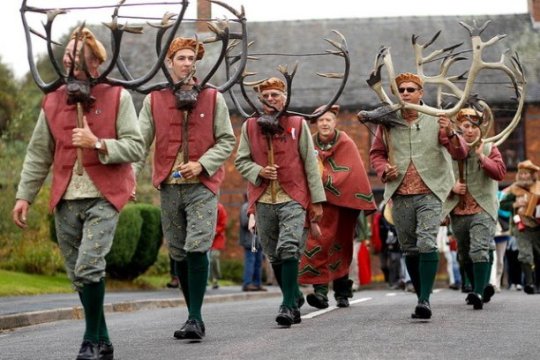
The Day of the Horned God of Britain is an ancient pagan holiday. This forest deity had many names and was known far beyond the borders of Britain. In Wales he was called Ato, the Horned God; in Windsor Forest, Ernie the Hunter; sometimes he was also called Cernunnus. But no matter what name he wore, no matter how he was portrayed, he had one invariable distinguishing feature - deer antlers on his head.
Locals claim that Ernie the Hunter still wanders through the woods in the vicinity of Windsor Castle. In 1964, he was seen rushing through the forest riding a fire-breathing horse.
And nowadays, in some areas of Britain, the Great Horn Holiday is celebrated in autumn. Men walk the streets with deer antlers attached to their heads. This is a reminder that the ancient forest deity disposes of the fertility of forest animals.
*Translated using an electronic dictionary. The original text in Russian and much more on the criminal topic can be selected on the main page of the site - http://crimerecords.info/
2 notes
·
View notes
Text
October 12 – Columbus Day
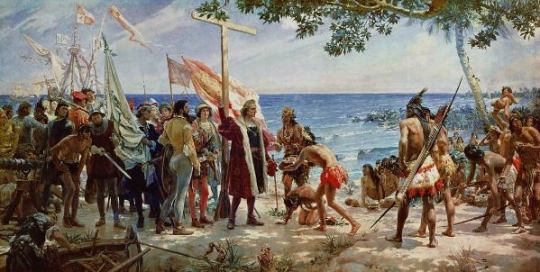
Jose Garnelo y Alda. "The landing of Christopher Columbus on the island of Guanahani in 1492."
Columbus Day is a holiday in honor of the anniversary of Columbus' arrival in America, which occurred on October 12, 1492. On this day, the expedition of Christopher Columbus reached the island of San Salvador in the Bahamas Archipelago, which was later taken as the official date of the discovery of America.
In Spain, October 12 is a public holiday and is called "Hispanidad Day". Columbus Day is a public holiday in many parts of the United States, but in some states, it is not celebrated. But, where it is celebrated, there is a holiday with parades and various shows.
Read more in the photo rating "Swings of the fate of Christopher Columbus"
*Translated using an electronic dictionary. The original text in Russian and much more on the criminal topic can be selected on the main page of the site - http://crimerecords.info/
0 notes
Text
September 30 – Jose Morelos Day in Mexico

Jose Maria Teclo Morelos y Pavón (José María Teclo Morelos y Pavón) is a Roman Catholic priest who, after the execution of Miguel Hidalgo y Costilla in 1811, led the uprising of the Mexican people for independence, a national hero of Mexico. For some reason, it is not the day of his execution that is celebrated, but his birthday. He was born on September 30, 1765 in Valladolid (now Morelia).
In November 1815, Morelos' detachment was defeated by the Spaniards near Puebla. He himself, having sent the rest of the soldiers away so that they would not be captured, was captured by the Spanish authorities. Morelos was accused of treason to the king, the country and God. First he appeared before the ecclesiastical court. There, among other things, he was also accused By the decision of the ecclesiastical court, on November 27, in the chapel of the Holy Office, he was deprived of his spiritual dignity, after which he was handed over to a civil court. It is said that he refused the prison guard's offer to arrange his escape, fearing that his savior might also be executed.

On Friday, December 22, 1815, at about six o'clock in the morning, Morelos woke up in his cell, ate bread and drank coffee. Then they chained his hands and feet and took him to Ecatepec near Mexico City under the protection of 50 soldiers, because they were afraid of a riot. He was delivered to Ecatepec at one o'clock in the afternoon. I had lunch there. Morelos blindfolded himself, took the crucifix and exclaimed: "Lord, if I have done well, you know it, but if I have done wrong, I will find refuge in your infinite mercy." Then he knelt with his back to the platoon. At four o'clock in the afternoon, two volleys were fired.

The struggle for independence led by him was continued by his deputy Vicente Guerrero. Morelos was posthumously rehabilitated by the church, and proclaimed a national hero of Mexico. In the city of Morelos, on Michoacan Island in Hanizio, a statue was erected to him in 1947.
*Translated using an electronic dictionary. The original text in Russian and much more on the criminal topic can be selected on the main page of the site - http://crimerecords.info/
0 notes
Text
September 29 - Saint Hripsime's Memorial Day in the Catholic Church

In 301, 37 Christian virgins arrived in Armenia, who fled Rome as a result of persecution of Christians. Conquered by the beauty of one of them, a maiden named Hripsime, King Trdat III wished to possess her. The refusal of the virgin, who declared that she belonged only to Christ, led the king into an indescribable rage. He ordered to kill Hripsime, her mentor Gayane and their friends who had made the same vow.
But anyway. Trdat actually created two holidays for Armenia with one action. Hripsime and 32 friends were executed in the northeastern part of Vagharshapat.
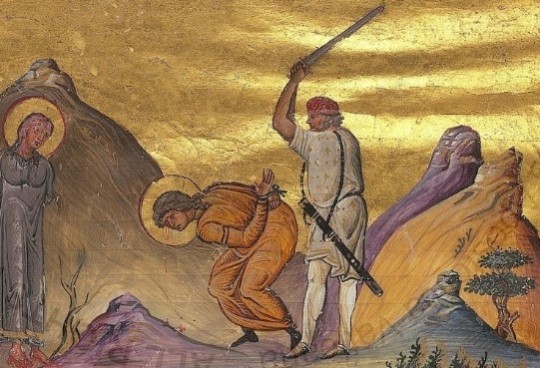
The sufferings of Ripsimia and Gaiania. Byzantine miniature.
In honor of this event, Saint Hripsime's Memorial Day is celebrated in Armenia on different days. And her mentor Gayane, along with two virgins, was executed in the southern part of the city, so in Armenia they also celebrate Saint Gayane's Memorial Day. Another sick virgin was tortured right in the press. But her memory is not widely celebrated. Another Christian virgin named Nina somehow escaped the massacre. Now she is called the Baptist of Georgia.
Read more in the post "Bloody Baptism of Armenia".
*Translated using an electronic dictionary. The original text in Russian and much more on the criminal topic can be selected on the main page of the site - http://crimerecords.info/
0 notes